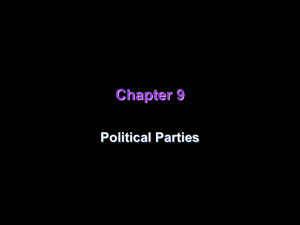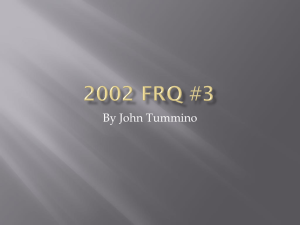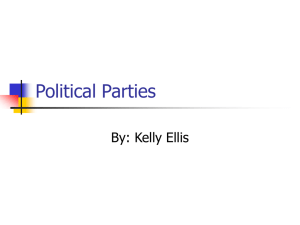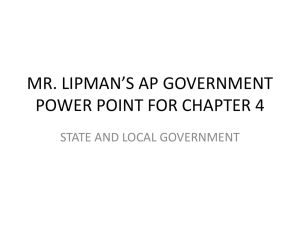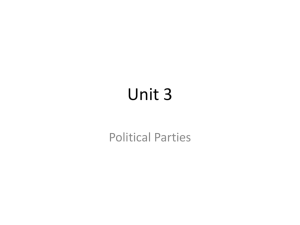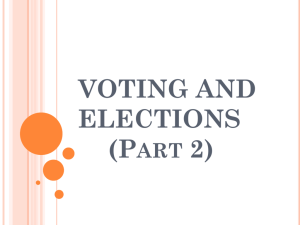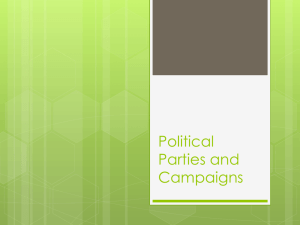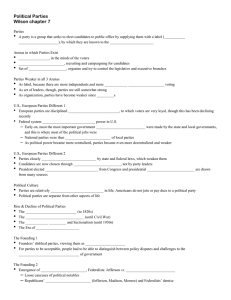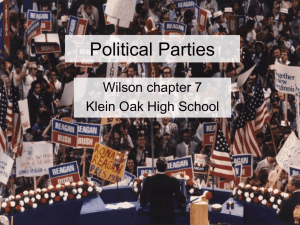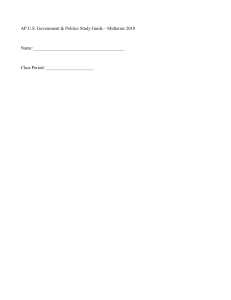Political Culture - MisterWoodyNotebook
advertisement
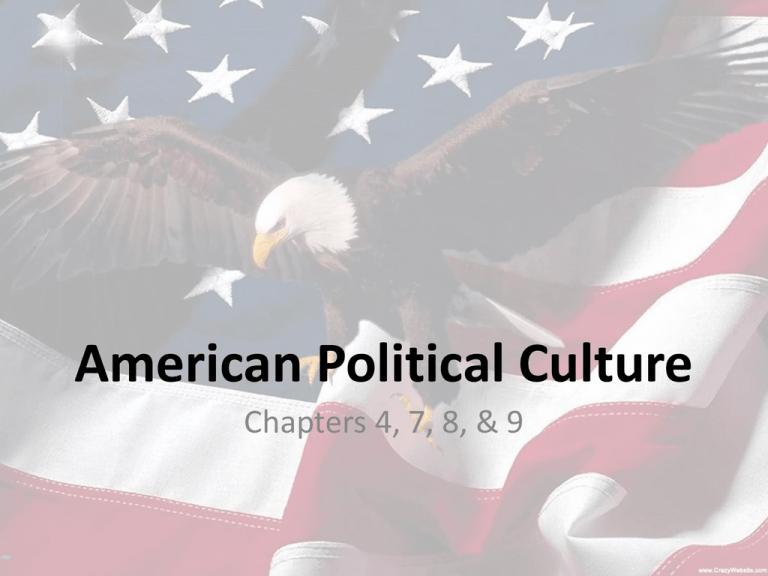
American Political Culture Chapters 4, 7, 8, & 9 Alexis de Toqueville • Democracy in America • The effects of “culture” • “Problems” of America – – – – – – Size Languages “melting pot” Religion Class Consciousness Political Equality over Economic Equality Elements of the American Political System • • • • • • • Liberty Equality Democracy Civic Duty Individual Responsibility The Role of the Civil Society The Necessity of Political Tolerance • How do we know that Americans share these beliefs? • Why is our society inconsistent with our beliefs? • Why is there so much political conflict? • Does the economy reflect our values? • What is the affect of Religion? • Are we Red, Blue, or Purple? Elements of the American Political System • Proper Definition of Terms – Conservative – Liberal • Where did the Political Spectrum originate? The Political Spectrum The Political Spectrum The Political Spectrum Check YOUR Political Standing • http://www.gotoquiz.com/politics/politicalspectrum-quiz.html The Value of Public Opinion • Plenty of Problems: – There are many “publics” – Difficult to measure accurately – “We know very little, but we reason fairly well.” • Errors occur: – We don’t use terms correctly. – Our desires are inconsistent. – We hide our truest thoughts. • “Public opinion is often dynamic, not static.” “Inside Information” • Table 4.2 ~ Survey says: We take more pride, believe that we are in control, think kids should be taught the value of hard work, and believe that belief in God is essential to morality than Europe. • Table 4.3 ~ In the past 40 years, confidence in church, schools, newspapers, unions, business, and Congress have all declined. • Table 7.1 ~ young adults are pretty jaded. Scientific Polling • • • • • • • Straw polls George Gallup Random sampling Margin of error (sampling error) Exit polls Effect of Elites Bill Clinton – Overpolling? Political Socialization • • • • • • • • Family Age Education Religion Gender Class Race/Ethnicity Region (basics > party) (kids less partisan) (younger = more socially liberal) (more schooling = less partisan) (attendance increases Conserv.) (Women!) (Economics trumps all.) (Party and Issues) (“Stronghold” – myth?) How do we participate? • • • • • • • • Voting “Getting out” the vote Campaigning Donating Being informed Signing petitions Letter-writing Volunteer work A Brief History of Voting • • • • • • • • • 1776 ~ White, male, taxpayers (property) 1828 ~ Removal of most property requirements 1868 ~ Amd. 14 – male citizens, age 21 1870 ~ Amd. 15 – race, color, servitude 1920 ~ Amd. 19 – sex 1961 ~ Amd. 23 – District of Columbia 1964 ~ Amd. 24 – No poll taxes 1971 ~ Amd. 26 – Age 18 “Motor voter” laws Other voting issues • NonVoting – Too busy (25%) – Family obligations (12%) – Lack of efficacy (12%) • • • • Disenfranchisement of Criminals Literacy Tests Grandfather Clauses Numerous offices Voting Trends • Chart page 185 – Older voters vote in larger percentages – Presidential elections draw larger turnouts than Midterm elections – Less than half of registered voters ages 18-20 vote in Midterms – Younger voters fluctuate more (disinterest?) – 2008 got the most out of every group Choose your ballot wisely • • • • • Early Party “Ballots” The Australian Ballot “Office bloc” Ballot (Mass.) Straight ticket? Voting machines – The Lever – The Punch Card (The Florida Fiasco - 2000) – The Video Game Political Parties • Despised by the Founders – Factional – Fighting – Treasonous? • A basic label – Becoming less descriptive • Perhaps in decline (but probably not) A Brief History of Political Parties • Federalists vs. Democratic-Republicans – (Adams vs. Jefferson) – Killed the caucus system, created Conventions • Whigs vs. Democrats – (Clay vs. Jackson) • Republicans vs. Democrats – Created by Civil War – Union = Republican / Confederacy = Democrat A Brief History of Political Parties • William Jennings Bryan – Populism – Progressives and Mugwumps • MAJOR CHANGES: – Primary elections, Nonpartisan local elections – Voters’ registration – Initiative and Referendum – Use of mass media – Decrease in patronage A Brief History of Political Parties • FDR and the Final Domination of Democrats • Alternating Current – Democrats have controlled Congress – Republicans have “controlled” the Presidency – Continuous divided government An even briefer history of “minor” parties • • • • • 1964 – George Wallace 1980 – John Anderson 1992 & 1996 – Ross Perot 2000 – Ralph Nader and Pat Buchanan 2010 – Tea Party 2 Parties or Multiple? • Problems in a 2-Party system – Contentiousness – Corruption – Divisiveness • Problems in a Multiparty system – Coalitions – Run-offs – Plurality Political Conventions • • • • Primary or Caucus? “Superdelegates” Usually activists Delegates do NOT reflect the masses Who’s at the convention? Democrats % Republicans % Women 49 32 Blacks 23 2 Protestant 50 57 Catholic 25 30 Jewish 9 3 College degree 80 80 Income < $500,000 45 32 Income > $500,000 43 51 Union members 25 5 Born-again 14 34 Gun Owners 33 60 Who’s at the convention? 2008 Dem Delegates % Voters % Rep. Delegates % Male 50 46 68 Female 50 54 32 African American 23 12 2 Hispanic 11 8 5 Income > $75,000 70 31 66 Union Members 24 9 5 TOTAL (#) 4419 2380 Govt. must solve national problems 83 43 3 Should have stayed out of Iraq 95 59 13 Abortion should be generally available 70 33 9 Religion ext. import 23 28 37 Restrict guns – laws 62 52 8 No legal gay unions 5 39 46 The problem of corruption • Patronage – “To the victor…” • Tammany Hall • Political Machines • Hatch Act Questions • If we do away with political parties… – How will candidates be found? – How will good candidates be recruited? – Where will candidates find support? – Who will hold candidates accountable for their actions? • Why don’t the best people run for office?
